Abstract
What’s Trade Got to Do with It? Relative Demand for Skills within Swedish Manufacturing. — This paper seeks to identify the contribution of trade and technological change to the increase in inequality between skilled and unskilled workers in Sweden since the 1970s. An empirical approach is adopted which allows for the outsourcing of the low-skill parts of the production chain to low-wage locations and is applied to detailed industry and bilateral trade data, the latter distinguishing between low-wage sources of imports and OECD countries. The paper finds that, in contrast to previous studies, trade with low-wage countries may have contributed to the rise in inequality in Swedish manufacturing. The empirical results also suggest that the increased use of technology also played a role in creating greater inequality between skilled and unskilled workers in Sweden, with the magnitude of this impact increasing in the 1990s.
Similar content being viewed by others
References
Anderton, R., and P. Brenton (1998a). Trade with the NICs and Wage Inequality: Evidence from the United Kingdom and Germany. In P. Brenton and J. Pelkmans (eds.),Global Trade and European Workers. Basingstoke: Macmillan.
Anderton, R., and P. Brenton (1998b). The Dollar, Trade, Technology and Inequality in the USA.National Institute Economic Review 166: 78–86.
Anderton, R., and P. Brenton (1999). Outsourcing and Low-Skilled Workers in the UK.Bulletin of Economic Research 51: 267–286.
Anderton, R., and S. Schultz (1999). Explaining Export Success in the UK and Germany: A Case Study of the Medical Equipment Industry. Anglo-German Foundation Report. London.
Berman, E., J. Bound, and Z. Grilliches (1994). Changes in the Demand for Skilled Labor within U.S. Manufacturing: Evidence from the Annual Survey of Manufactures.Quarterly Journal of Economics 109: 367–398.
Berman, E., J. Bound, and S. Machin (1998). Implications of Skilled Biased Technological Change: International Evidence.Quarterly Journal of Economics 113: 1245–1280.
Borjas, G., R. Freeman, and L. Katz (1992). On the Labour Market Effects of Immigration and Trade. In G. Borjas and R. Freeman (eds.),Immigration and the Work Force: Economic Consequences for the United States and Source Areas. Chicago: University of Chicago Press.
Brenton, P., and J. Pelkmans (eds.) (1998).Global Trade and European Workers. Basingstoke: Macmillan.
Diehl, M. (1999). The Impact of International Outsourcing on the Skill Structure of Employment: Empirical Evidence from German Manufacturing Industries. Kiel Working Paper 946. Kiel Institute for World Economics, Kiel.
Edin, P., and B. Holmlund (1995). The Swedish Wage Structure: The Rise and Fall of Solidarity Wage Policy? In R. Freeman and L. Katz (eds.),Differences and Changes in Wage Structures. Chicago: University of Chicago Press.
Feenstra, R., and G. Hanson (1995). Foreign Investment, Outsourcing and Relative Wages. Working Paper 5121. NBER, Cambridge, Mass.
Feenstra, R., and G. Hanson (1996). Globalization, Outsourcing and Wage Inequality.American Economic Review, Papers and Proceedings 86 (2): 240–245.
Greenaway, D., and D. Nelson (2001). Globalisation and Labour Market Adjustment. Special issue ofOxford Review of Economic Policy 16.
Hansson, P. (1997). Trade, Technology and Changes in Employment of Skilled Labour in Swedish Manufacturing. In J. Fagerberg, P. Hansson, L. Lundberg, and A. Melchior (eds.),Technology and Trade. Cheltenham: Edward Elgar.
Hansson, P. (2000). Relative Demand for Skills in Swedish Manufacturing: Technology or Trade?Review of International Economics 8: 533–555.
Machin, S., and J. Van Reenen (1998). Technology and Changes in Skill Structure: Evidence from Seven OECD Countries.Quarterly Journal of Economics 111: 195–226.
Machin, S., A. Ryan, and J. Van Reenen (1996). Changes in Skill Structure: Evidence from an International Panel of Industries. Discussion Paper 1434. CEPR, London.
Sachs, J., and H. Shatz (1994). Trade and Jobs in U.S. Manufacturing.Brookings Papers on Economic Activity (1): 1–69.
Sachs, J., and H. Shatz (1996). US Trade with Developing Countries and Wage Inequality.American Economic Review, Papers and Proceedings 86: 234–239.
Wood, A. (1994).North-south Trade, Employment and Inequality. Oxford: Clarendon Press.




